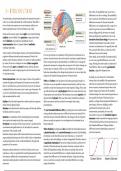Summary
Summary mid-term Sensation & Perception
- Course
- Institution
- Book
This summary contains the material for the first exam of the Sensation & Perception course () at Utrecht University. This material has been covered during the lectures and contains everything that you should know. It is a very well-arranged summary with images, in which all material is compact but ...
[Show more]




